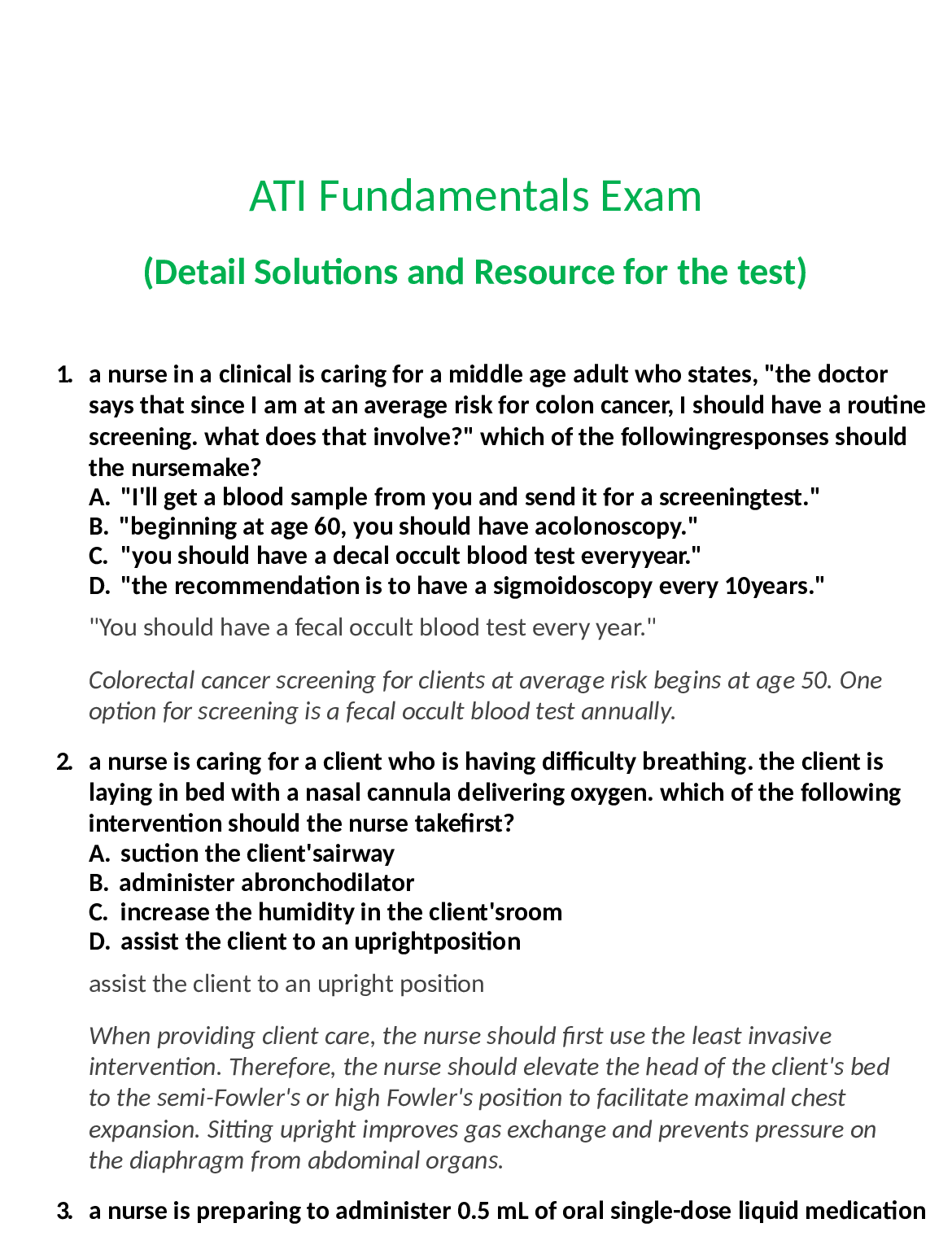*NURSING > QUESTIONS & ANSWERS > Miami University Of Ohio > NUR 323 Final Exam (GRADED A) (All)
Miami University Of Ohio > NUR 323 Final Exam (GRADED A)
Document Content and Description Below
Final Exam Review 1. Which of the following is not considered a risk factor for the development of melanoma? a. Light hair and eyes b. Female gender c. Severe sunburns in childhood d. 1-4 dyspl... astic moles 2. When using the otoscope to inspect the nose, which of the following structures is not visible? a. Inferior turbinate b. Middle turbinate c. Superior turbinate d. All of the above 3. When you are palpating the thyroid, which of the following is true? a. Flex the neck slightly backward b. Place the index fingers just above the cricoid cartilage c. The thyroid isthmus may not be palpable d. A bruit auscultated over the lateral lobe is expected 4. During the palpation of a patients thyroid gland, you note a multinodular gland. Which of the following is the first on your list of differential diagnoses? a. Thyroid cancer b. Hashimotos thyroiditis c. Graves disease d. A metabolic process 5. You are evaluating a 4 year old male patient with ear pain. You note the patient has a temperature of 102.4F. While performing your exam, you note the patient is pulling at his left ear. What is your most likely differential diagnosis? a. Otitis externa b. Otitis media c. Tinnitus d. Ottorhea 6. You are using a Snellen chart to evaluate a patients visual acuity, which of the following is true (select all that apply) a. Have the patient stand back 20ft from the chart b. Have the patient use their hand to cover one eye c. You are evaluating cranial nerve II d. Evaluate visual acuity with both eyes open 7. Grading system for tonsils: 0-4 for tonsils. a. 0-absent tonsils: tonsillectomy b. +1: 25% visibility of the tonsils c. +2:normal: 50% d. +3: hypertrophy/infection 8. within 48-72 hrs after the birth, a neonate has bilateral copious purulent drainage from the eyes. Your most likely differential diagnosis is? a. Gonococcal conjunctivitis b. Allergic conjunctivitis c. Bacteria conjunctivitis d. Viral conjunctivitis 9. Which of the following are normal findings during the ophalmascope examination? Select all that apply. a. The physiologic cup is 70% of the optic disk b. The area of the macula is absent in blood vessels c. The optic rim is fuzzy in appearance d. The optic disk is orange in appearance 10. You are beginning the examination of the skin on a 25-year-old teacher. You have previously elicited that she came to the office for evaluation of fatigue, weight gain, and hair loss. You strongly suspect that she has hypothyroidism. What is the expected moisture and texture of the skin of a patient with hypothyroidism? a. Moist and rough b. Dry and smooth c. Moist and smooth d. Dry and rough 11. A 72-year-old teacher comes to a skilled nursing facility for rehabilitation after being in the hospital for 6 weeks. She was treated for sepsis and respiratory failure and had to be on the ventilator for 3 weeks. You are completing your initial assessment and are evaluating her skin condition. On her sacrum there is full-thickness skin loss that is 5 cm in diameter, with damage to the subcutaneous tissue. The underlying muscle is not affected. You diagnose this as a pressure ulcer. What is the stage of this ulcer? a. Stage 3 b. Stage 4 c. Stage 1 d. Stage 2 12. A 68-year-old retired farmer comes to your office for evaluation of a skin lesion. On the right temporal area of the forehead, you see a flattened papule the same color as his skin, covered by a dry scale that is round and feels hard. He has several more of these scattered on the forehead, arms, and legs. Based on this description, what is your most likely diagnosis? a. Squamous cell carcinoma b. Actinic keratosis c. Basal cell carcinoma d. Seborrheic keratosis 13. Mrs. Hill is a 28-year-old African-American with a history of SLE (systemic lupus erythematosus). She has noticed a raised, dark red rash on her legs. When you press on the rash, it doesn't blanch. What would you tell her regarding her rash? a. It is likely to be related to an exposure or a chemical b. It is likely to be related to her lupus c. It should not cause her any problems d. It is likely to be related to an allergic reaction 14. Jacob, a 33-year-old construction worker, complains of a “lump on his back” over his scapula. It has been there for about a year and is getting larger. He says his wife has been able to squeeze out a cheesy-textured substance on occasion. He worries this may be cancer. When gently pinched from the side, a prominent dimple forms in the middle of the mass. What is most likely? a. An actinic keratosis b. An enlarged lymph node c. A malignant lesion d. A sebaceous cyst 15. A 38-year-old accountant comes to your clinic for evaluation of a headache. The throbbing sensation is located in the right temporal region and is an 8 on a scale of 1 to 10. It started a few hours ago, and she has noted nausea with sensitivity to light; she has had headaches like this in the past, usually less than one per week, but not as severe. She does not know of any inciting factors. There has been no change in the frequency of her headaches. She usually takes an over-the-counter analgesic and this results in resolution of the headache. Based on this description, what is the most likely diagnosis of the type of headache? a. Tension b. Cluster c. Migraine d. Analgesic rebound 16. Which of the following is a “red flag” regarding patients presenting with headache? a. Unilateral headache b. Phonophobia and photophobia c. Age over 50 d. Pain over the sinuses 17. Very sensitive methods for detecting hearing loss include which of the following? a. The whisper test b. Audiometric testing c. The tuning fork test d. The finger rub test 18. A college student presents with a sore throat, fever, and fatigue for several days. You notice exudates on her enlarged tonsils. You do a careful lymphatic examination and notice some scattered small, mobile lymph nodes just behind her sternocleidomastoid muscles bilaterally. What group of nodes is this? a. Tonsillar b. Posterior cervical c. Occipital d. Submandibular 19. A 35-year-old archaeologist comes to your office (located in Phoenix, Arizona) for a regular skin check-up. She has just returned from her annual dig site in Greece. She has fair skin and reddish-blonde hair. She has a family history of melanoma. She has many freckles scattered across her skin. From this description, which of the following is not a risk factor for melanoma in this patient? a. Heavy sun exposure b. Age c. Hair color d. Actinic lentigenes 20. When assessing the patients thought content, it is important to always follow specific questions to keep the patient on task. a. True b. False 21. Which of the following is true about hallucinations? a. Experiences may or may not be recognized by the person as false b. Halluciations may be auditory, visual, olfactory, gustatory, tactile, or somatic c. Do not include false perceptions associated with dreaming and falling asleep d. All of the above 22. Coordination of muscle movement requires that four areas of the nervous system function in an integrated way. Coordinating eye, head and body movemets applies to which area of the nervous system? a. Motor system b. Cerebellar system c. Vestibular system d. Sensory system 23. Tinels sign 24. Phalens sign 25. Which of the following statements regarding reinforcement when assessing reflexes is true? a. Used when reflexes are symmetrically hyperactive b. Technique involves isometric contraction of other muscles c. Supports the unsteady patient d. All of the above 26. A patient presents to you with shoulder pain after falling during an ice storm. On examination, he exhibits localized shoulder pain when you perform the “crossover test (arm moved across the chest toward the opposite side while extended at the elbow). Which of the following is the most likely site of injury? a. Rotator cuff b. Bicipital tendon c. Glenohumeral joint d. Acromioclavicular joint 27. A patient who presents to clinic complaining of hand pain says she was told by a friend that is most likely carpal tunnel syndrome. Upon assessing the patient, you note the following findings. Which would be suggestive of carpal tunnel syndrome? a. Hand pain when holding both hands in acute extension b. Numbness and tingling when tapping over the course of the radial nerve c. Symptoms related to compression are evident in all of the fingers d. None of the above 28. You are assessing a patient with joint pain and are trying to decide whether it is inflammatory or noninflammatory in nature. Which one of the following symptoms is consistent with an inflammatory process? a. Nodules b. Ecchymosis c. Cool temperature d. Tenderness 29. An 85-year-old retired housewife comes with her daughter to establish care. Her daughter is concerned because her mother has started to fall more. As part of her physical examination, you ask her to walk across the examination room. Which of the following is not part of the stance phase of gait? a. Push off b. Foot arched c. mid stance d. heel strike 30. A 32-year-old warehouse worker presents for evaluation of low back pain. He notes a sudden onset of pain after lifting a set of boxes that were heavier than usual. He also states that he has numbness and tingling in the left leg. He wants to know if he needs to be off of work. What test should you perform to assess for a herniated disc? a. Tinels test b. Leg length test c. Straight leg raise d. Phalens test 31. A high school soccer player “blew out his knee” when the opposing goalie's head and shoulder struck his flexed knee while the goalie was diving for the ball. All of the following structures were involved in some way in his injury, but which of the following is actually an extra-articular structure? a. Juxta-articular bone b. Joint capsule c. Synovium d. Tendons 32. A 28-year-old book editor comes to your clinic, complaining of strange episodes. He states that about once a week for the last 3 months his left hand and arm will stiffen and then start jerking. He says that after a few seconds his whole left arm and then his left leg will also start to jerk. He denies any loss of consciousness or loss of bowel or bladder control. When the symptoms resolve, his arm and leg feel tired but otherwise he feels fine. His past medical history is significant for a cyst in his brain that was removed 6 months ago. He is married and has two children. His parents are both healthy. On examination you see a scar over the right side of his head but otherwise his neurologic examination is unremarkable. What type of seizure disorder is he most likely to have? a. Simple partial seizure (jacksonian) b. Complex partial seizure c. Generalized absence seizure d. Generalized tonic clonic seizure 33. A 21-year-old engineering student comes to your office, complaining of leg and back pain and of tripping when he walks. He states this started 3 months ago with back and buttock pain but has since progressed to feeling weak in his left leg. He denies any bowel or bladder symptoms. He can think of no specific traumatic incidences but he was a defensive lineman in high school and junior college. His past medical history is unremarkable. He denies tobacco use or alcohol or drug abuse. His parents are both healthy. On examination he is tender over the lumbar spine and he has a positive straight-leg raise on the left. His Achilles tendon deep reflex is decreased on the left. While watching his gait you notice he has to pick his left foot up high in order not to trip. What abnormality of gait does he most likely have? a. Steppage gait b. Sensory ataxia c. Spastic hemiparesis d. Parkinsonian gait 34. Steve has had a stroke and comes to you for follow-up today. On examination you find that he has increased muscle tone, some involuntary movements, an abnormal gait, and a slowness of response in movements. He most likely has involvement of which of the following? a. The basal ganglia b. The cerebellum c. The corticospinal tract d. The cerebrum 35. A 19-year-old college student, Todd, is brought to your clinic by his mother. She is concerned that there is something seriously wrong with him. She states for the past 6 months his behavior has become peculiar and he has flunked out of college. Todd denies any recent illness or injuries. His past medical history is remarkable only for a broken foot. His parents are both healthy. He has a paternal uncle who had similar symptoms in college. The patient admits to smoking cigarettes and drinking alcohol. He also admits to marijuana use but none in the last week. He denies using any other substances. He denies any feelings of depression or anxiety. While speaking with Todd and his mother you do a complete physical examination, which is essentially normal. When you question him on how he is feeling, he says that he is very worried that Microsoft has stolen his software for creating a better browser. He tells you he has seen a black van in his neighborhood at night and he is sure that it is full of computer tech workers stealing his work through special gamma waves. You ask him why he believes they are trying to steal his programs. He replies that the technicians have been telepathing their intents directly into his head. He says he hears these conversations at night so he knows this is happening. Todd's mother then tells you, “See, I told you . . . he's crazy. What do I do about it?” While arranging for a psychiatry consult, what psychotic disorder do you think Todd has? a. Schizophrenia b. Subtstance induced psychotic disorder c. Scizoaffective disorder d. Psychotic disorder due to a medical illness 36. A 24-year-old secretary comes to your clinic, complaining of difficulty sleeping, severe nightmares, and irritability. She states it all began 6 months ago when she went to a fast food restaurant at midnight. While she was waiting in her car a man entered through the passenger door and put a gun to her head. He had her drive to a remote area, where he took her money and threatened to kill her. When the gun jammed he panicked and ran off. Ever since this occurred the patient has been having these symptoms. She states she jumps at every noise and refuses to drive at night. She states her anxiety has had such a marked influence on her job performance she is afraid she will be fired. She denies any recent illnesses or injuries. Her past medical history is unremarkable. On examination you find a nervous woman appearing her stated age. Her physical examination is unremarkable. You recommend medication and counseling. What anxiety disorder to you think this young woman has? a. Generalized anxiety disorder b. Post traumatic stress disorder c. Specific phobia d. Acute stress disorder 37. A 72-year-old African-American male is brought to your clinic by his daughter for a follow-up visit after his recent hospitalization. He had been admitted to the local hospital for speech problems and weakness in his right arm and leg. On admission his MRI showed a small stroke. The patient was in rehab for 1 month following his initial presentation. He is now walking with a walker and has good use of his arm. His daughter complains, however, that everyone is still having trouble communicating with the patient. You ask the patient how he thinks he is doing. Although it is hard for you to make out his words you believe his answer is “well . . . fine . . . doing . . . okay.” His prior medical history involved high blood pressure and coronary artery disease. He is a widower and retired handyman. He has three children who are healthy. He denies tobacco, alcohol, or drug use. He has no other current symptoms. On examination he is in no acute distress but does seem embarrassed when it takes him so long to answer. His blood pressure is 150/90 and his other vital signs are normal. Other than his weak right arm and leg his physical examination is unremarkable. What disorder of speech does he have? a. Dysarthia b. Wernickes aphasia c. Brocas aphasia 38. A young Hispanic mother brings in her 2-month-old son. She is upset because her neighbors have threatened to call the Child Protective Agency because they think his birthmark is a bruise. Her son was the product of an uneventful pregnancy and spontaneous vaginal delivery. On examination you see a large, smooth-bordered bluish mark on his buttock and lower back. Otherwise his examination is unremarkable. What form of birthmark is this likely to be? a. Mongolian spot b. Café-au-lait spot c. Salmon patch [Show More]
Last updated: 2 years ago
Preview 1 out of 10 pages

Buy this document to get the full access instantly
Instant Download Access after purchase
Buy NowInstant download
We Accept:

Reviews( 0 )
$10.00
Can't find what you want? Try our AI powered Search
Document information
Connected school, study & course
About the document
Uploaded On
Apr 19, 2020
Number of pages
10
Written in
Additional information
This document has been written for:
Uploaded
Apr 19, 2020
Downloads
0
Views
105

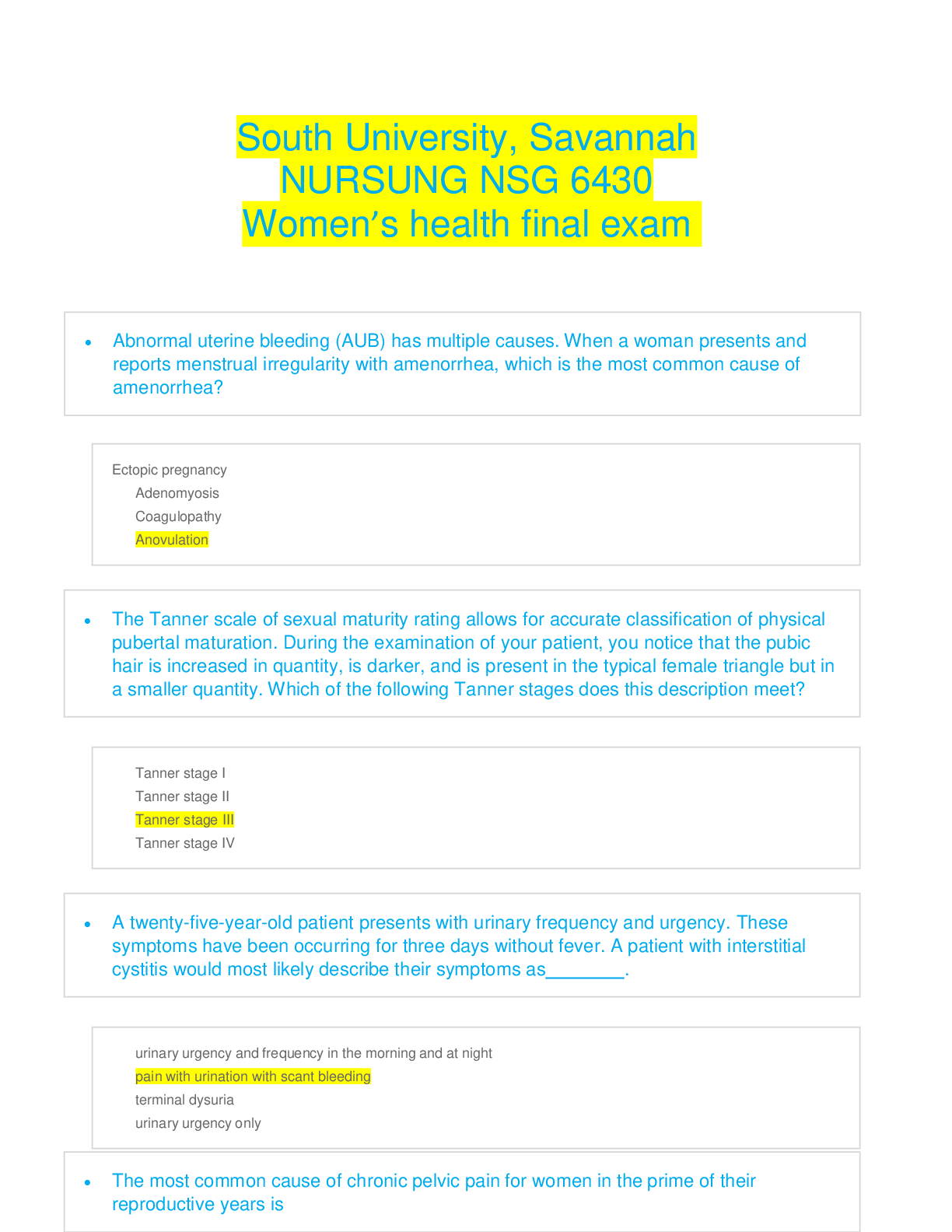

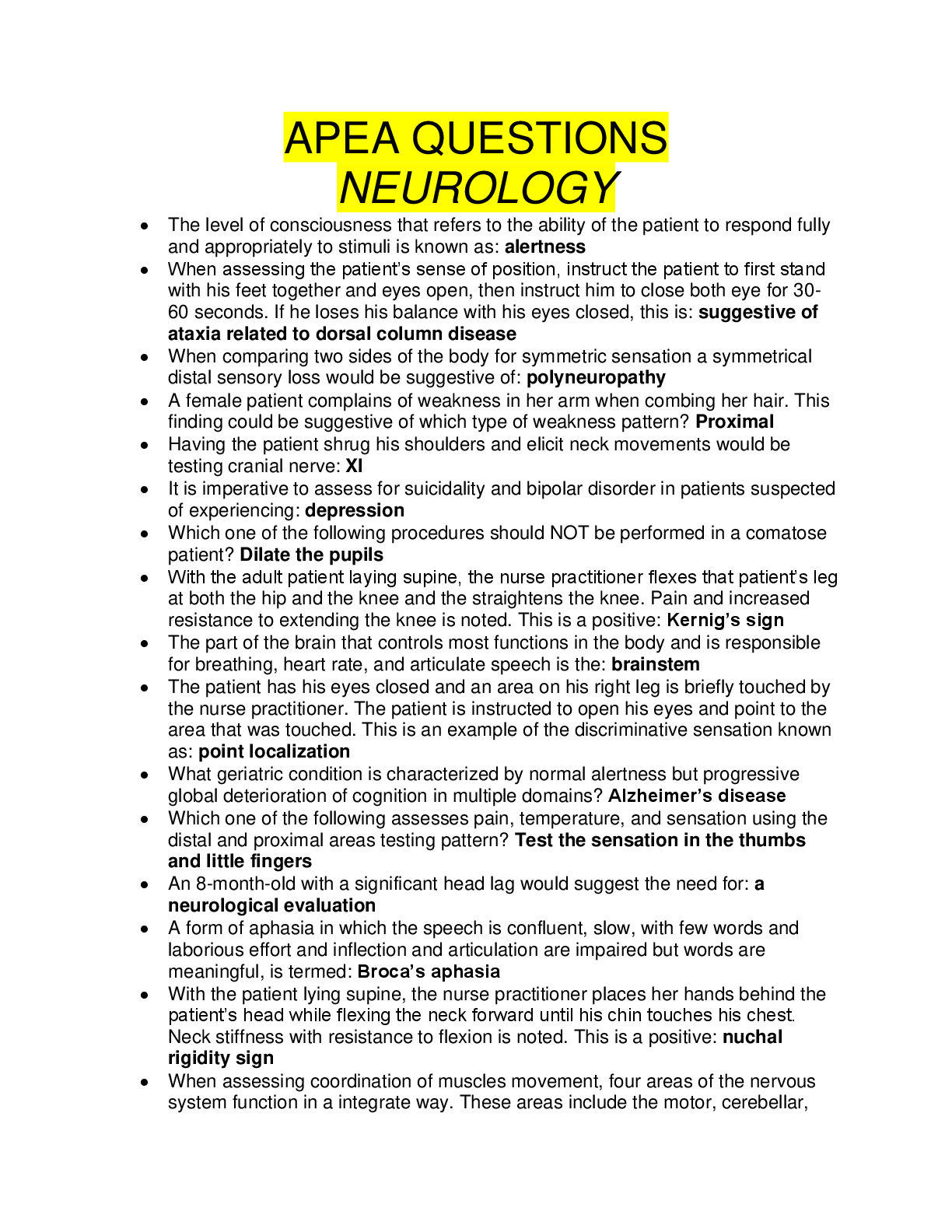

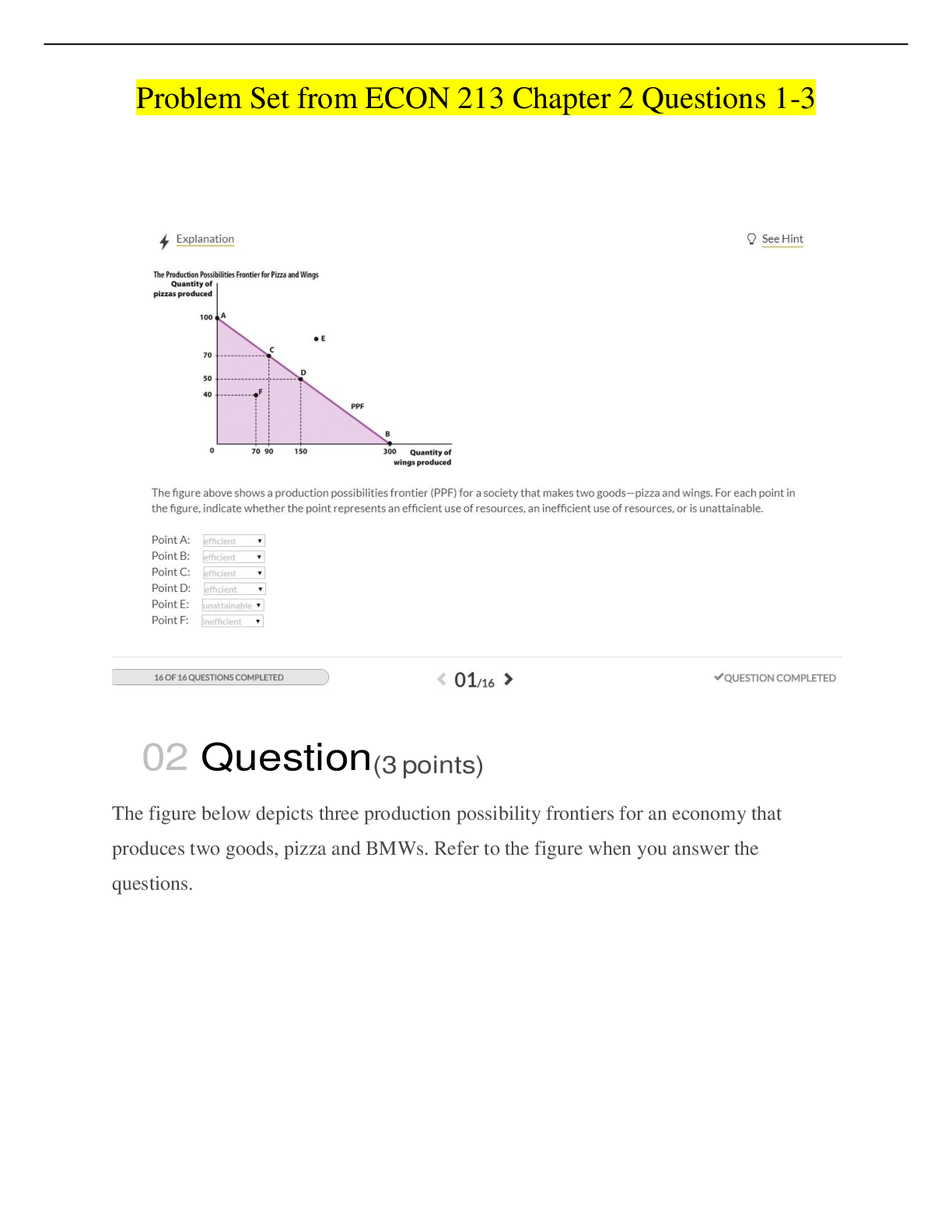
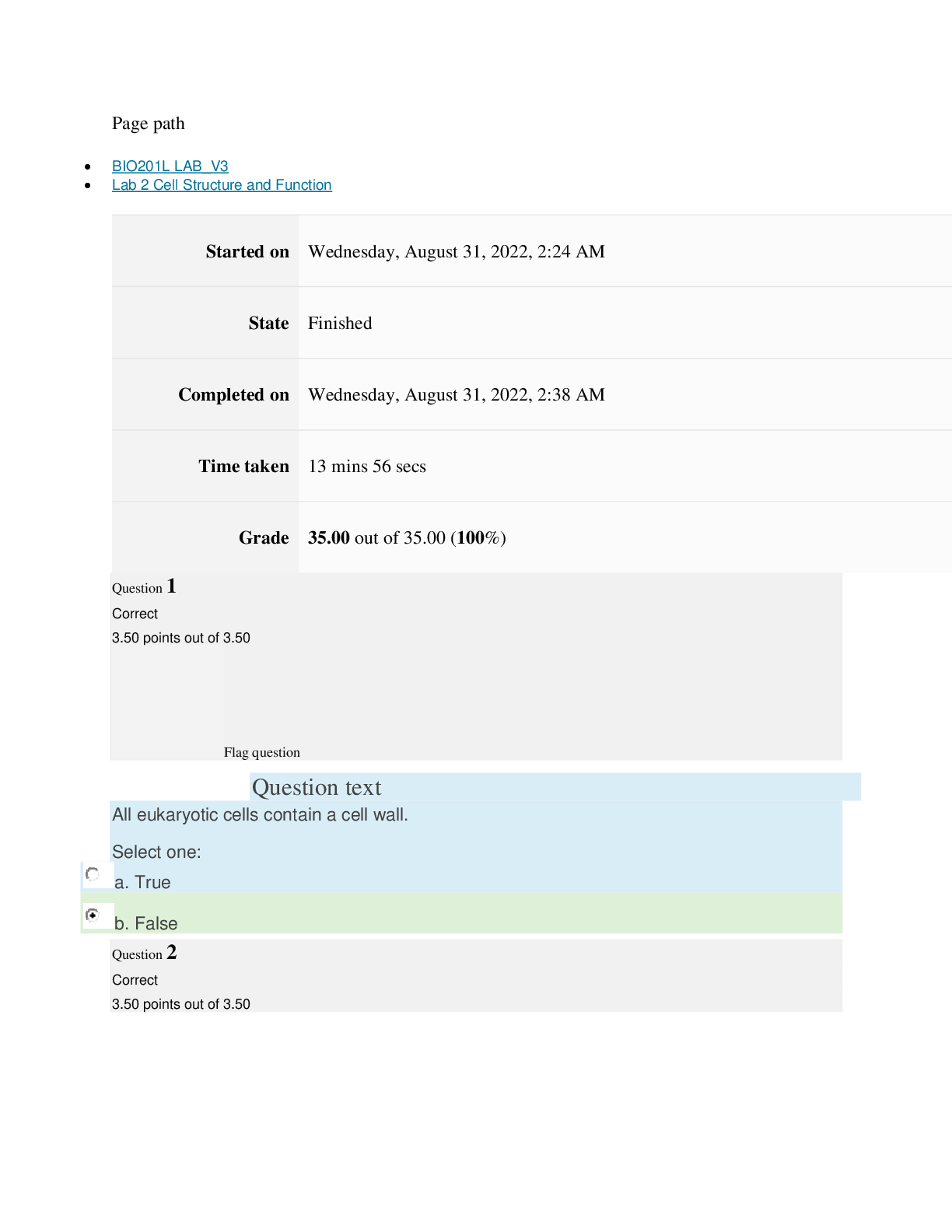

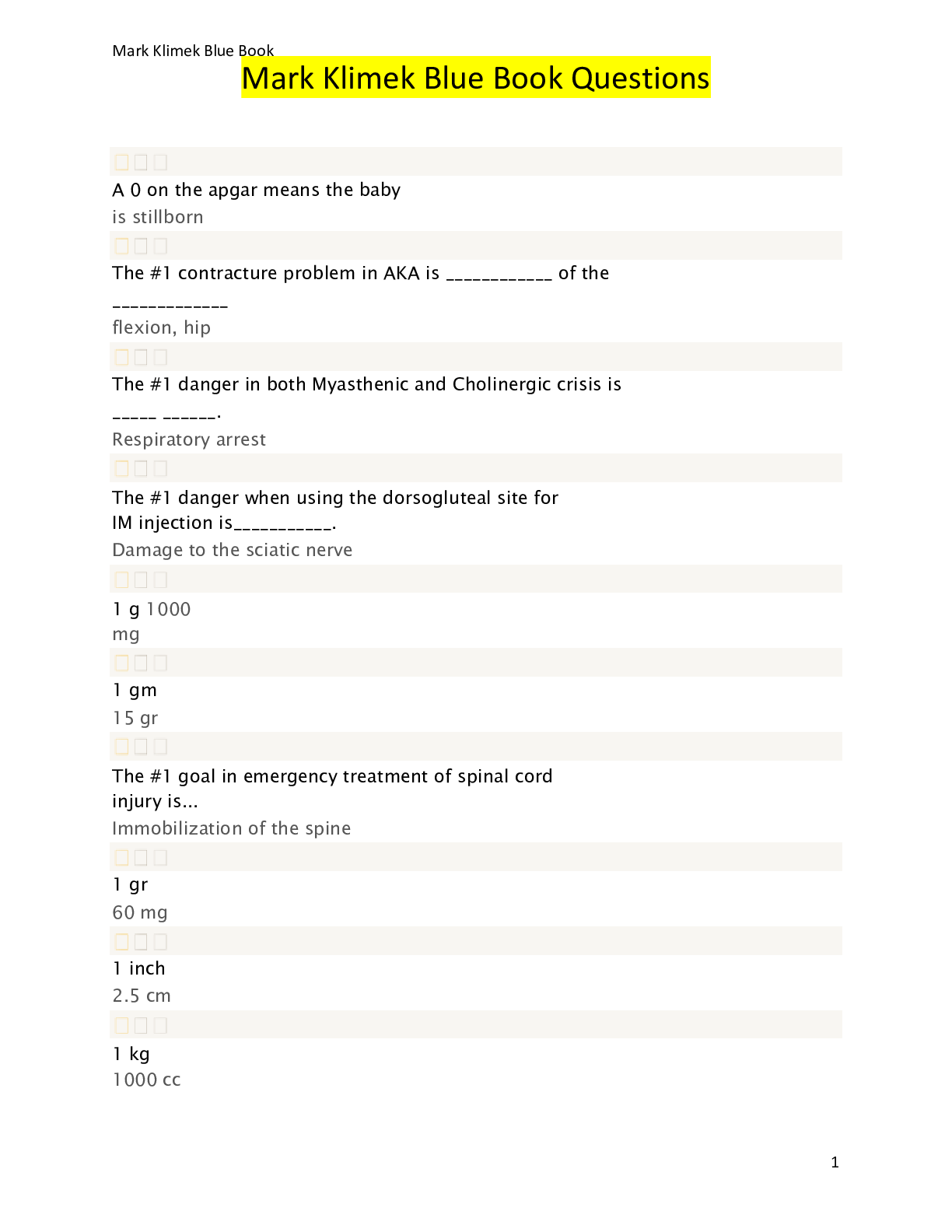

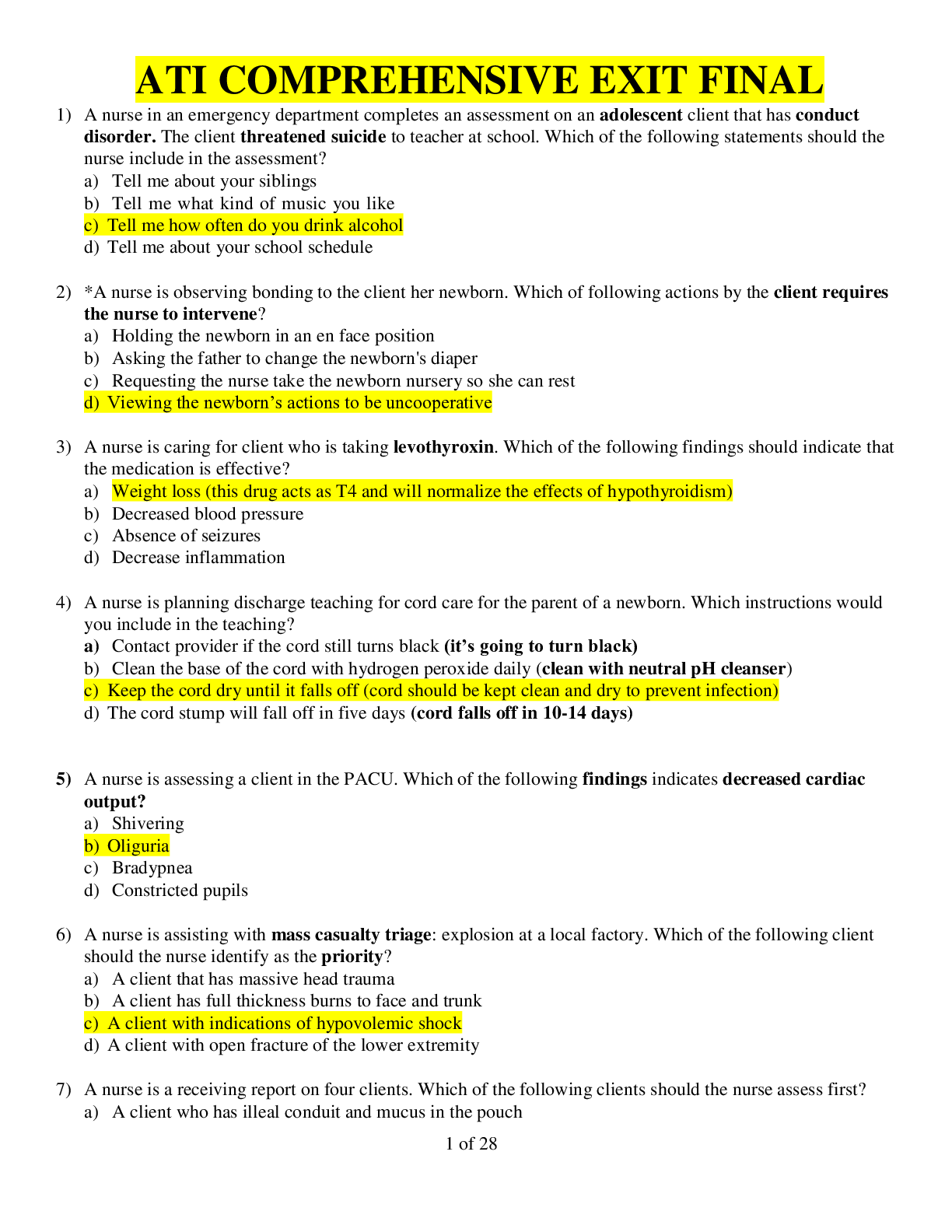











.png)
